Advantages
The advantages of a kiteboat over a traditional sailboat are manifold. As a kite pulls a boat, it does not also heel the boat over or pitch it forward as a sail does. This fact means that a kiteboat does not require large counterbalancing forces which, in opposing the heeling and pitching forces of a sail, create drag and present practical problems. The absence of this behavior means that the only limit on kite size is kite control, since increasing the power made by the kite does not require increasing ballast or beam, for example, which are limiting factors on a sailboat. Kites can fly higher than sails, too, which grants them access to stronger, steadier, higher-altitude winds, and kites can be maneuvered through the air to create more apparent wind. This maneuvering generates extra power, which is not possible with a fixed sail on a mast.
Finally, a kite lifts the boat out of the water as it propels it forward, which effectively reduces the displacement and decreases drag. While any boat would benefit from this boost, a hydrofoil benefits especially, because the kite reduces the amount of lift required from (and drag created by) the foils, and the lack of heeling and pitching forces makes reliably maintaining trim and ride height much more practicable. It is not necessary for a kiteboat to be a hydrofoil boat, but for us, this configuration represents a perfect marriage of technology.
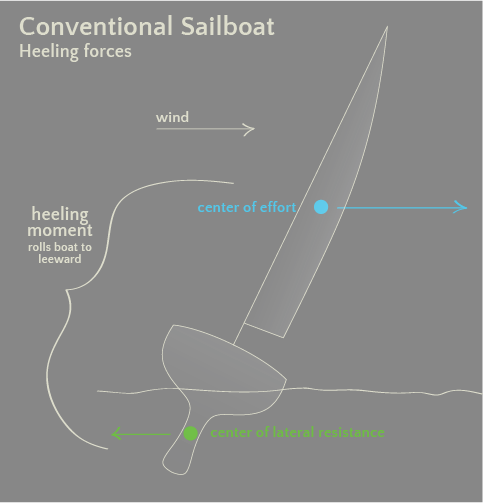
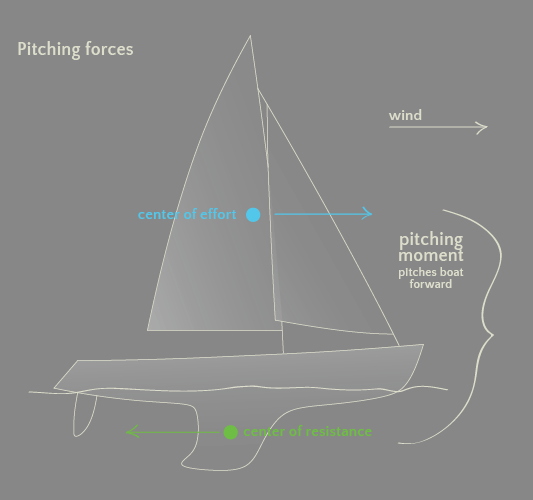
A fundamental advantage of a kiteboat over a sailboat with a conventional rig is that the kiteboat can be arranged so that the kite creates no significant heeling or pitching moments on the boat. Without these moments there is essentially no limit to the size of kite that can be used with any particular size or weight of boat, and, hence, no limit on the amount of power that can be applied to the boat. With a conventional rig, increases in power must be accompanied by increases in righting moment, which inevitably result in increased drag, limiting the performance of the boat. On a such a rig, the lift created by the sails is applied to the boat (through the mast and rigging) at the center of effort (which is more or less at the height of the center of area of the sails), high above the deck. Because it is centered at this height, in addition to pushing the boat forward and to leeward, this force creates heeling and pitching moments that roll the boat to leeward and pitch it forward. These moments must be countered by a righting moment created by the horizontal distance between the boat’s center of buoyancy and its center of gravity.
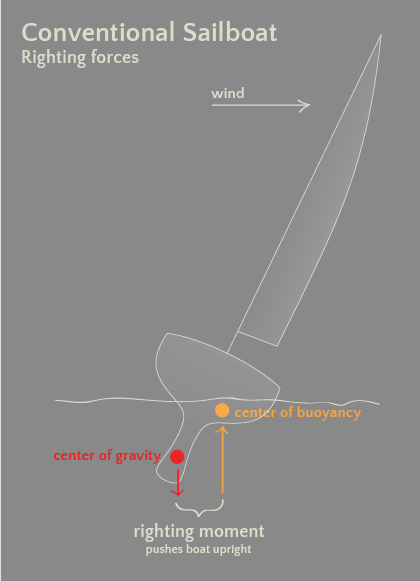
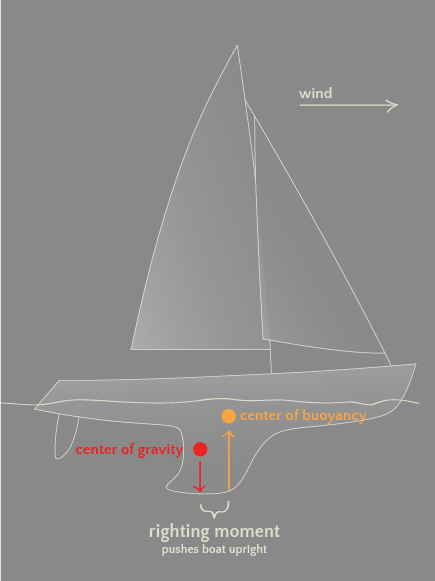
On a conventional monohull, the righting moment is achieved by adding ballast to the boat’s keel, which brings the center of gravity (CG) low enough that as the boat heels, the CG swings to windward, relative to the hull. At the same time, the center of buoyancy (CB) moves to leeward slightly, as more of the hull is immersed on the leeward side and the windward side lifts out of the water. The horizontal distance so created between the upward buoyant force of the water acting on the boat at the CB and the downward force of gravity acting at the CG creates a moment which tries to bring the boat upright.
As the force on the sails causes the boat to heel, this distance (and the moment it creates) increases until the righting moment reaches an equilibrium with the heeling moment and the boat takes on a steady trim. If the sail area is increased, the righting moment must be increased in proportion, or the boat will be overpowered. The only way to increase the righting moment is to increase the amount of ballast or to increase the depth of the ballast keel. Of course, increasing the amount of ballast adds to the weight of the boat, increasing the displacement and causing more drag. Increasing the depth of the keel increases wetted surface, creating more surface friction and more induced drag. Increasing the depth of the keel also has structural disadvantages and prevents the boat from entering areas of relatively shallow draft. What all this essentially means is that as power is increased, drag is increased in proportion, setting a limit on the performance potential of the boat.
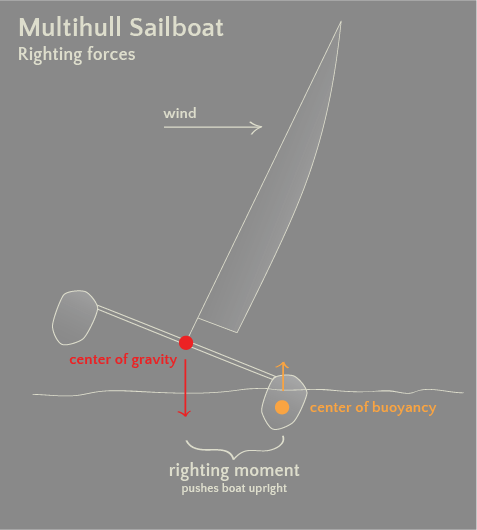 On a multihull with a conventional rig, the righting moment is created not by adding ballast low on the keel, so that the CG moves to windward as the boat heels, but instead by spacing the hulls wide apart, so that the CB moves to leeward. If the boat reaches the point of flying the windward hull(s), the CB is centered in the leeward hull, and the CG is on the centerline of the boat. This creates a moment arm equal in length to half the beam of the boat. If the sail area is increased, the boat will become overpowered unless the righting moment is increased in proportion, either by adding weight to the boat or by spacing the hulls further apart (and making them longer to resist the added pitching moment). Adding weight obviously increases displacement and drag. Spacing the hulls further apart inevitably adds weight and air resistance, as well as having structural disadvantages and significantly reducing maneuverability and preventing the boat from entering narrow channels or slips. Making the hulls longer adds weight and wetted surface, increasing drag. This performance trade-off also applies to monohulls (in which the righting moment can be increased by making the boat wider, increasing the amount to which the CB moves to leeward as the boat heels), except that drag increases even more rapidly with added width, as the added wetted surface, displacement, and width increase skin friction and wave-making drag.
On a multihull with a conventional rig, the righting moment is created not by adding ballast low on the keel, so that the CG moves to windward as the boat heels, but instead by spacing the hulls wide apart, so that the CB moves to leeward. If the boat reaches the point of flying the windward hull(s), the CB is centered in the leeward hull, and the CG is on the centerline of the boat. This creates a moment arm equal in length to half the beam of the boat. If the sail area is increased, the boat will become overpowered unless the righting moment is increased in proportion, either by adding weight to the boat or by spacing the hulls further apart (and making them longer to resist the added pitching moment). Adding weight obviously increases displacement and drag. Spacing the hulls further apart inevitably adds weight and air resistance, as well as having structural disadvantages and significantly reducing maneuverability and preventing the boat from entering narrow channels or slips. Making the hulls longer adds weight and wetted surface, increasing drag. This performance trade-off also applies to monohulls (in which the righting moment can be increased by making the boat wider, increasing the amount to which the CB moves to leeward as the boat heels), except that drag increases even more rapidly with added width, as the added wetted surface, displacement, and width increase skin friction and wave-making drag.
In contrast, a kiteboat can be arranged such that the force generated by the kite acts on the boat through the kitelines along a line which, if extended, would pass relatively near the CG and the center of lateral resistance. (The center of lateral resistance is the point at which the lift to windward generated by the keel or foils acts, as it prevents the boat from being pulled to leeward by the sail.) No significant moments are created, either by inertial effects as the boat accelerates, or by the opposing forces of the foils and the kite. This effectively means that the kite has no tendency to roll or pitch the boat. Kite size can be be increased indefinitely without increasing drag or causing the boat to have any tendency to capsize, pitchpole (flip end over end), or become overpowered. As long as the kite can be controlled, and the power it creates transmitted to the boat, there is effectively no limit on the amount of power that can be applied to the boat, and hence no limit to its performance potential.
 Using a kite instead of a conventional rig has other performance benefits as well. Because the kite lines pull on the boat at an upward angle, the lift generated by the kite helps to pull the boat out of the water as well as to pull it forward, decreasing displacement and drag (and in the case of a hydrofoil boat, facilitating foiling), whereas the rig on a conventional boat actually depresses the boat as it heels, increasing drag. While it is theoretically possible to achieve this absence of heeling moment and vertical component of lift by leaning a conventional rig to windward, such boats are only able to sail on one tack (unless there is a mechanism to cant the entire rig from side to side), and they still have significant pitching moment, requiring more buoyancy and drag to resist pitchpoling. A kiteboat also has access to stronger, steadier wind at higher altitudes, which a kite can take advantage of while a conventional rig sees weaker, more turbulent wind. Also, a kite can be maneuvered through the air, creating more apparent wind over the kite. This capability allows the kite steerer to create surges of power on demand, or to maintain performance as the wind decreases.
Using a kite instead of a conventional rig has other performance benefits as well. Because the kite lines pull on the boat at an upward angle, the lift generated by the kite helps to pull the boat out of the water as well as to pull it forward, decreasing displacement and drag (and in the case of a hydrofoil boat, facilitating foiling), whereas the rig on a conventional boat actually depresses the boat as it heels, increasing drag. While it is theoretically possible to achieve this absence of heeling moment and vertical component of lift by leaning a conventional rig to windward, such boats are only able to sail on one tack (unless there is a mechanism to cant the entire rig from side to side), and they still have significant pitching moment, requiring more buoyancy and drag to resist pitchpoling. A kiteboat also has access to stronger, steadier wind at higher altitudes, which a kite can take advantage of while a conventional rig sees weaker, more turbulent wind. Also, a kite can be maneuvered through the air, creating more apparent wind over the kite. This capability allows the kite steerer to create surges of power on demand, or to maintain performance as the wind decreases.
Additionally, the benefits of a hydrofoil are more readily exploited by a kite than by a conventional rig. These benefits include lower drag and the ability to sail over swells or chop without losing much speed or being buried in spray. When the hulls of a foiling boat are lifted entirely clear of the water, all the drag associated with displacement, including skin friction and wave-making drag, is eliminated. The only remaining contributors to hydrodynamic drag are the skin friction of the foils (which is comparable to the skin friction of the keel of a conventional boat) and the induced drag associated with the creation of lift by the foils. Thus, total drag is greatly reduced, and higher speeds are possible for any given amount of thrust. By lifting up above the water, a hydrofoil also escapes many of the problems caused by a choppy sea state. A conventional boat attempting to travel at high speeds over rough water provides a very wet, bumpy ride, and is significantly slowed each time it encounters the face of a wave. A hydrofoil, sailing above the water surface, can maintain speed and provide a smooth, dry ride.
A kite rig is particularly well-suited to a hydrofoil boat. The vertical component of the force that the kite creates physically raises the boat, and it lowers the minimum speed at which the boat will foil. It also, at any foiling speed, decreases the amount of required lift, which reduces the amount of induced drag created by the foils. Because using a kite eliminates the large heeling and pitching moments associated with a conventional sailplan, a kiteboat is virtually immune to the catastrophic failures to which sailing hydrofoils are prone, making kitefoiling a much easier, safer, and more reliable endeavor. By the time a conventionally-rigged hydrofoil has reached foiling speeds, its sails are generally creating a huge heeling moment. This must be countered by a correspondingly large amount of lift from the leeward foil, and in some cases, by negative lift from the windward foil, actually pulling the windward side of the boat down. In this situation, if the windward foil were to cease to be effective (e.g. by leaving the water as a wave trough passed) the boat would immediately capsize to leeward. The high speeds and low drag associated with foiling, coupled with the large pitching moment created by rig set on a mast, make conventionally rigged foil-boats prone to pitchpoling as well. If, when sailing at high speed on the foils, the bows of such a boat hit a wave, the sudden large increase in drag forward (combined with the pitching force on the sails and the momentum of a boat with CG lifted up above the water) encourages the boat to pitchpole. In contrast, if the foils of a kitefoiler leave the water, or if the bows dig into a wave, the boat has no tendency to flip. The kite just continues to uplift and pull the boat until normal foiling is re-established, with the boat maintaining more or less constant trim throughout.